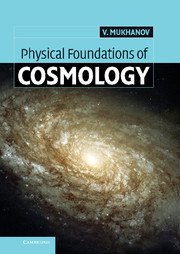Book contents
- Frontmatter
- Contents
- Foreword by Professor Andrei Linde
- Preface
- Acknowledgements
- Units and conventions
- Part I Homogeneous isotropic universe
- 1 Kinematics and dynamics of an expanding universe
- 2 Propagation of light and horizons
- 3 The hot universe
- 4 The very early universe
- 5 Inflation I: homogeneous limit
- Part II Inhomogeneous universe
- Bibliography
- Index
1 - Kinematics and dynamics of an expanding universe
from Part I - Homogeneous isotropic universe
Published online by Cambridge University Press: 05 September 2012
- Frontmatter
- Contents
- Foreword by Professor Andrei Linde
- Preface
- Acknowledgements
- Units and conventions
- Part I Homogeneous isotropic universe
- 1 Kinematics and dynamics of an expanding universe
- 2 Propagation of light and horizons
- 3 The hot universe
- 4 The very early universe
- 5 Inflation I: homogeneous limit
- Part II Inhomogeneous universe
- Bibliography
- Index
Summary
The most important feature of our universe is its large scale homogeneity and isotropy. This feature ensures that observations made from our single vantage point are representative of the universe as a whole and can therefore be legitimately used to test cosmological models.
For most of the twentieth century, the homogeneity and isotropy of the universe had to be taken as an assumption, known as the “Cosmological Principle.” Physicists often use the word “principle” to designate what are at the time wild, intuitive guesses in contrast to “laws,” which refer to experimentally established facts.
The Cosmological Principle remained an intelligent guess until firm empirical data, confirming large scale homogeneity and isotropy, were finally obtained at the end of the twentieth century. The nature of the homogeneity is certainly curious. The observable patch of the universe is of order 3000 Mpc (1 Mpc ≃ 3.26 × 106 light years ≃ 3.08 × 1024 cm). Redshift surveys suggest that the universe is homogeneous and isotropic only when coarse grained on 100 Mpc scales; on smaller scales there exist large inhomogeneities, such as galaxies, clusters and superclusters. Hence, the Cosmological Principle is only valid within a limited range of scales, spanning a few orders of magnitude.
Moreover, theory suggests that this may not be the end of the story. According to inflationary theory, the universe continues to be homogeneous and isotropic over distances larger than 3000 Mpc, but it becomes highly inhomogeneous when viewed on scales much much larger than the observable patch.
- Type
- Chapter
- Information
- Physical Foundations of Cosmology , pp. 3 - 36Publisher: Cambridge University PressPrint publication year: 2005
- 2
- Cited by



